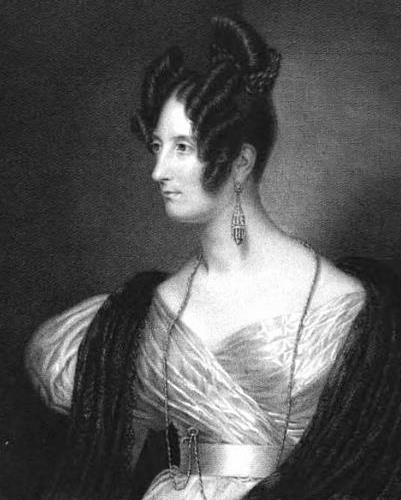
by Laura Knight
~~~

Charlotte Knight (c.1801-1843) was the youngest daughter and heiress of the botanist Thomas Andrew Knight, a member of a wealthy iron-founding dynasty founded by his grandfather Richard Knight of the Bringewood Ironworks in Shropshire. Her father was the heir of his brother the art connoisseur Payne Knight (d.1824), MP, who rebuilt Downton Castle in Shropshire.
In 1824, Downton Castle was inherited by Charlotte. She was the wife of Sir William Edward Rouse-Boughton, 2nd and 10th Baronet (1788-1856), of Downton Hall, Stanton Lacy, Shropshire, (about 6 miles (9.7 km) to the NE of Downton Castle), a Member of Parliament for Evesham in Worcestershire. As her eldest son was heir to his father's estates and two baronetcies, she bequeathed the estate to their second son Andrew Rouse-Boughton-Knight (d.1947), who in 1857 adopted the additional surname of Knight. He served as High Sheriff of Herefordshire in 1860 and at that time began improvements and extensions to the house, including a new entrance and porch, a north west tower, and a chapel. He added terraced gardens in 1865 to the design of W.A. Nesfield. In 1881 the family resided there with twelve servants. He died at Downton Castle in 1947.
In 1817, aged just 16, Charlotte Knight was presented with the Silver Medal of the Horticultural Society of London (now the Royal Horticultural Society) in recognition of the quality of the Waterloo cherry. Her father, himself a noted botanist, had written in 1816 that the new variety "sprang from a seed of the Ambrée of Du Hamel and the pollen of the May-Duke". It was named after the Battle of Waterloo, which had taken place two years before in 1815, as it had fruited first at Elton Hall in Herefordshire a few days after Napoleon's defeat at that battle. It ripens early, in late June to early July, and can serve as a pollinator to later varieties.
She was mentioned in the Transactions of the Horticultural Society of London which was published in 1818.It credited her for raising the early black cherry otherwise known as the Waterloo cherry.
The writer and gardener Christopher Stocks notes in his book Forgotten Fruits (2008) that Charlotte Knight "deserves posthumous recognition" given how rare it was for women to generate new cultivars: "of all the hundreds of varieties of fruits and vegetables in this book, Waterloo is the only one not to have been created by a man".
In 1824 she married Sir William Edward Rouse-Boughton, 2nd and 10th Baronet (1788–1856), a member of parliament for Evesham in Worcestershire, by whom she had 3 sons and 5 daughters, including:
1. Sir Charles Henry Rouse-Boughton, 3rd and 11th Baronet (1825–1906), eldest son and heir.
2. Andrew Johnes Rouse-Boughton, 2nd son, who inherited Downton Castle in Shropshire, one of the Knight estates inherited by his mother, and adopted the surname Knight.
3. Catherine Rouse-Boughton.
Charlotte Boughton was buried in the parish church of Rous Lench in Worcestershire. Her portrait, painted by Henry Collen and engraved by John Cochran, was published in the Court Magazine in July 1834. A copy is in the National Portrait Gallery, London which also has two photographs of her daughter Catherine.